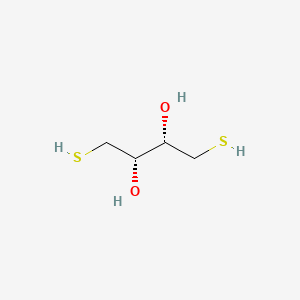



API Suppliers
0

US DMFs Filed
0

CEP/COS Certifications
0

JDMFs Filed
0
EU WC
0
Listed Suppliers
0

USA (Orange Book)
0

Europe
0

Canada
0

Australia
0

South Africa
0
Uploaded Dossiers
0
U.S. Medicaid
0
Annual Reports
0
0
USFDA Orange Book Patents
0
USFDA Exclusivities
0
Blog #PharmaFlow
0
News
0
EDQM
0
USP
0
JP
0
Other Listed Suppliers
0
0


1. Cleland Reagent
2. Cleland's Reagent
3. Clelands Reagent
4. Dithiothreitol
5. Reagent, Cleland
6. Reagent, Cleland's
7. Sputolysin
1. Dithiothreitol
2. Dl-1,4-dithiothreitol
3. 3483-12-3
4. Dl-dithiothreitol
5. 1,4-dithiothreitol
6. D-dithiothreitol
7. D-1,4-dithiothreitol
8. 27565-41-9
9. D-dtt
10. (2s,3s)-1,4-bis(sulfanyl)butane-2,3-diol
11. (2s,3s)-1,4-disulfanylbutane-2,3-diol
12. Dtt
13. Mfcd00004877
14. D-threo-1,4-dimercapto-2,3-butanediol
15. Threo-1,4-dimercapto-2,3-butanediol
16. Chebi:42170
17. Cis-2,3-dihydroxy-1,4-butanedithiol
18. 35454-97-8
19. Sputolysin
20. Rac-dithiothreitol
21. Dtv
22. 1,4-dithiothreithol
23. Dithio Threitol
24. Wr 34678
25. Reagents, Cleland's
26. 2,3-butanediol, 1,4-dimercapto-, (r*,r*)-
27. (+/-)-dithiothreitol
28. Dl-dithiothreitol, 99%
29. Dl-dithiothreitol, Powder
30. Dtt (threitol Derivative)
31. Dtt, 1,4-dithiothreitol
32. D,l-dithiothreitol (dtt)
33. Schembl10601
34. Threitol, 1,4-dithio-, L-
35. Chembl1232392
36. Dl-dithiothreitol, >=99.0%
37. Dtxsid5041017
38. Dithiothreitol, Biochemical Grade
39. 1,4-dimercapto-butane-2,3-diol
40. Zinc3852211
41. Einecs 240-263-0
42. Ethyl4-nitro-l-phenylalanine
43. Akos005259570
44. Akos015855399
45. Ccg-207964
46. Db02184
47. Dl-dithiothreitol, >=99.0% (rt)
48. Threitol, 1,4-dithio- (7ci,8ci)
49. Brn 2036371
50. Threo-2,3-dihydroxy-1,4-butanedithiol
51. Dl-1,4-dimercapto-2,3-dihydroxybutane
52. Dtt, Dithiothreitol (cleland's Reagenz)
53. (+/-)-1,4-dimercapto-2,3-butanediol
54. As-57473
55. Bp-22785
56. Dl-dithiothreitol Solution, 1 M In H2o
57. B7294
58. D97824
59. Dl-dithiothreitol, Bioultra, >=99.0% (rt)
60. Dl-dithiothreitol, For Electrophoresis, >=99%
61. M02712
62. M02716
63. (r-(r*,r*))-1,4-dimercaptobutane-2,3-diol
64. Dl-dithiothreitol, Saj Special Grade, >=98.0%
65. Dl-dithiothreitol, Vetec(tm) Reagent Grade, 98%
66. Q414783
67. (+/-) Dithiothreitol Molecular Biology Grade >99%
68. 2,3-butanediol, 1,4-dimercapto-, L-threo-
69. Dl-dithiothreitol, Bioxtra, >=99.0% (titration)
70. 2,3-butanediol, 1,4-dimercapto-, (r-(r*,r*))-
71. 2,3-butanediol, 1,4-dimercapto-, (2r,3r)-rel- (9ci)
72. Dl-dithiothreitol, >=98% (hplc), >=99.0% (titration)
73. Dl-dithiothreitol; Cleland Inverted Exclamation Mark S Reagent
74. Dl-dithiothreitol, Bioultra, For Molecular Biology, >=99.5% (rt)
75. Dl-dithiothreitol Solution, Bioultra, For Molecular Biology, ~1 M In H2o
76. Dl-dithiothreitol, For Molecular Biology, >=98% (hplc), >=99% (titration)
| Molecular Weight | 154.3 g/mol |
|---|---|
| Molecular Formula | C4H10O2S2 |
| XLogP3 | -0.4 |
| Hydrogen Bond Donor Count | 4 |
| Hydrogen Bond Acceptor Count | 4 |
| Rotatable Bond Count | 3 |
| Exact Mass | 154.01222190 g/mol |
| Monoisotopic Mass | 154.01222190 g/mol |
| Topological Polar Surface Area | 42.5 Ų |
| Heavy Atom Count | 8 |
| Formal Charge | 0 |
| Complexity | 52 |
| Isotope Atom Count | 0 |
| Defined Atom Stereocenter Count | 2 |
| Undefined Atom Stereocenter Count | 0 |
| Defined Bond Stereocenter Count | 0 |
| Undefined Bond Stereocenter Count | 0 |
| Covalently Bonded Unit Count | 1 |
Two male patients with late stage (uremic) infantile nephropathic cystinosis (INC) were treated by mouth with the reducing agent dithiothreitol (DTT), at doses not exceeding 25 mg/kg body weight three times per day. Three sequential periods of observation were obtained in both patients: on thiol (8.5 months); off thiol (8-9 months); on thiol again (7 months or longer)... Whereas chemical methods are not reliable for detecting and measuring DTT in biologic fluids, preliminary evidence indicates that a silylated derivative of oxidized DTT can be detected in the urine of patients receiving DTT by mouth. This finding suggests that the thiol is absorbed and excreted.
PMID:840501 Depape-Brigger D et al; Pediatr Res 11 (2): 124-31 (1977)
Two male patients with late stage (uremic) infantile nephropathic cystinosis (INC) were treated by mouth with the reducing agent dithiothreitol (DTT), at doses not exceeding 25 mg/kg body weight three times per day. Three sequential periods of observation were obtained in both patients: on thiol (8.5 months); off thiol (8-9 months); on thiol again (7 months or longer)... Whereas chemical methods are not reliable for detecting and measuring DTT in biologic fluids, preliminary evidence indicates that a silylated derivative of oxidized DTT can be detected in the urine of patients receiving DTT by mouth. This finding suggests that the thiol is absorbed and excreted.
PMID:840501 Depape-Brigger D et al; Pediatr Res 11 (2): 124-31 (1977)


